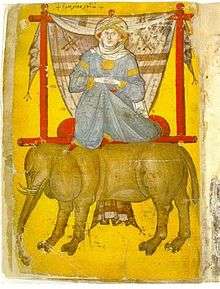Sittişah Hatun
| Sittî Şâh Hâtun ستی شاہ خاتون | |
|---|---|
 A 15th century idealized portrait of Mükrime Hatun, painted in Byzantine style | |
| Born |
Mükrime (Mükerreme)[1] c. ?[1] Elbistan, Beylik of Dulkadir |
| Died |
September 1486[1] Edirne, Ottoman Empire |
| Burial | Muradiye Complex, Bursa, Turkey |
| Spouse | Mehmed II |
| Father | Zülkadiroğlu Süleyman Bey of the Beylik of Dulkadir |
| Religion | Taṣawwufī Islam |
Sittî Mükerreme Hâtun or Sittişah Hatun, ( b. c. ? , Elbistan, Beylik of Dulkadir – d. September 1486, Edirne, Ottoman Empire),[1] was the third wife of Ottoman Sultan Mehmed II and the real-biological mother[2][3] of Ottoman Sultan Bayezid II. She was one of the daughters of Zülkadiroğlu Süleyman Bey, the sixth ruler of Dulkadir State. She was married to Mehmed II on December 15, 1449 in Edirne. Her marriage served as an alliance between the Ottomans and this buffer state.
Early life
Sittişah Hatun was born in 1435 in Elbistan, Kahramanmaraş Province, Dulkadir State. Born as Mükrime, she was the daughter of Süleyman Bey, the sixth ruler of Dulkadir State. Her aunt Emine Hatun, daughter of Nasıreddin Muhammed Bey, the fifth ruler of Dulkadirids was married to Sultan Murad's father Mehmed I. While her other aunt was married to the aged Mamluk Sultan at Cairo. Later Ayşe Gülbahar Hatun, Süleyman Bey's grand daughter, was married to the future Sultan Bayezid II and became the mother of Selim I, known as the grim.[4]
Süleyman Bey, who is described as a man of unshapely corpulence and pathological sensuality but also as a skillful horsemen and the owner of magnificent stables, possessed a considerable army of brave, devoted Turk men and was fabulously wealthy, two circumstances which in themselves sufficed to incline Murad toward the union of his son and heir with this respected noble families which centuries later, though dispossessed of its lands, was still revered as a family of royal blood. The Byzantine chronicler Ducas was convinced, not without reason, that one of the Sultan's chief motives in seeking this marriage was to obtain an ally against the arrogant Karamanids and Jahan Shah, the chief of the Turk men Black Sheep Tribe (Kara Koyunlu).[4]
Marriage
When Mehmed turned seventeen, his father decided that he should to married to a woman of inferior station for political purposes. The Sultan's choice fell on the wealthy and beautiful daughters of Süleyman Bey, the sixth ruler of Dulkadir State. It must have been in the winter of 1448-1449 that Murad summoned Çandarlı Halil Pasha, his trusted Grand Vizier, and informed him of the marriage plans. The Sultan declared that he wished the prince to marry and this time as he, Murad, saw fit. Halil Pasha approved wholeheartedly of his master's plan, whereupon they decided to choose one of Süleyman's daughters. The wife if Hizir Pasha, Governor of Amasya, was sent to Elbistan to select the bride in accordance with ancient custom. Her choice fell on Sittişah hatun, the most beautiful of the daughters; the intermediary kissed her eyes and put the engagement ring on the finger.[4]
Later the same matron, this time accompanied by Saruca Pasha, the Sultan's favoured adviser in family matters, returned to the court of Elbistan to bring the chosen bride home to Rumelia. The most distinguished nobles of the land escorted the young girl across the mountains to the former Ottoman capital of Bursa, where the judges, the ülema and the sheikhs of the religious orders came to meet her in solemn procession and then onward across the Dardanelles. At the news the cortege was approaching, Murad sent out the grandees of the realm from Edirne to meet his future daughter-in-law, who continued on the Sultan's residence with her imposing retinue.[4]
The wedding took place on 15 December 1449 at Edirne[5] and was celebrated with a great pomp for three months. Popular festivities of all sorts and poetry contests contributed to the rejoicings. The bridegroom, who had not been consulted on the choice of his bride, returned with her to Manisa immediately after the celebration. The marriage is seem to have childless and not very happy. Apparently, the whole arrangement was not to Mehmed's liking.[6]
Death
Long After Mehmed had removed his court to Istanbul, Sittişah Hatun remained behind Edirne, where she lived, lonely and forsaken, until the end of April 1467. She founded waqfs in Edirne and its region. Her waqf in the old Ottoman capital constructed a mosque finished in 1485. Two years after the conclusion of the building works Sittişah Hatun died. It is seemed likely that her niece Ayşe Gülbahar, in devotion to her memory, completed the mosque which bears her name and beside which she rests under the open sky in a grave now completely uncared for her. The two cracked tombstones have been removed from the shrubbery and taken to the city museum. The mosque is today used by a hay barn.[7]
References
- 1 2 3 4 Necdet Sakaoğlu (2008). Bu mülkün kadın sultanları: Vâlide sultanlar, hâtunlar, hasekiler, kadınefendiler, sultanefendiler. Oğlak publications. pp. 113–117. ISBN 978-9-753-29623-6..
- ↑ "Sultan II. Bayezid Han". Republic of Turkey Ministry of Culture and Tourism. Retrieved 6 February 2009.
- ↑ Yavuz Bahadıroğlu, Resimli Osmanlı Tarihi, Nesil Yayınları (Ottoman History with Illustrations, Nesil Publications), 15th Ed., 2009, page 129, ISBN 978-975-269-299-2
- 1 2 3 4 Babinger 1992, p. 57.
- ↑ Wedding portrait, Nauplion.net
- ↑ Babinger 1992, p. 57-8.
- ↑ Babinger 1992, p. 58.
Bibliography
- Franz Babinger (1992). Mehmed the Conqueror and His Time. Princeton University Press. ISBN 978-0-691-01078-6.